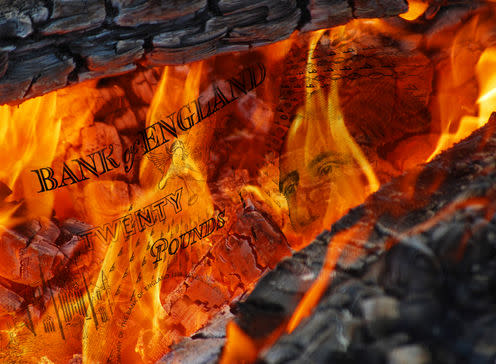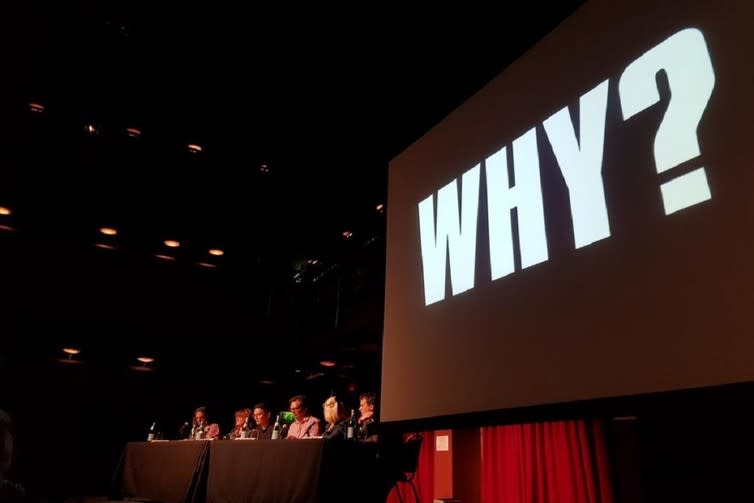The KLF are back – but are they any closer to answering that burning million pound question?
Burning issue.Shutterstock
For ravers of a certain age, the electronic band known (mostly) as the KLF provided many of the dance floor fillers of the early 1990s. What Time is Love? and 3am Eternal were part of the euphoria of club culture.
There was also the silliness of their novelty record, Doctorin’ the Tardis. And who could forget the deliberately perverse appearance of country singer Tammy Wynette on the baffling single Justified and Ancient?
The KLF were known for heavy-handed sampling, and bending every pop rule, until their career went up in flames over two decades ago.
Then, in the summer of 2017, they came back. In an ice cream van. To Liverpool, where an event was held in search of an explanation for KLF’s most notorious and controversial act – the burning of £1m in cash.
The money burning by the band’s two core members, Bill Drummond and Jimmy Cauty, was one of a series of subversive manoeuvres designed to “amend art history”.
The pair had previously fired blanks from a machine gun into a music industry crowd after being named best band at the Brit Awards in 1992. Two years later, as the K Foundation, they attempted to undermine the 1994 Turner Prize by awarding double the official prize money to the artist they considered to be the worst on the short list. (Rachel Whiteread won both “prizes”.)
Then finally, and famously, in August 1994 they took £1m to a remote Scottish island, where, in the middle of the night, they burned the lot.
Why Did the KLF Burn a Million Quid? was the name of an event that Drummond and Cauty toured around the UK shortly after the embers of their bonfire of vanities had died down. They had no convincing explanation for what they had done, and hoped other people could provide one.
But the tour was a disaster. People were angry. How could they have done something so reckless, so morally indefensible? They eventually resolved not to speak about it, and imposed a 23 year moratorium on the matter.
In August 2017, Why Did the KLF Burn a Million Quid? was also the title of the panel discussion I was invited to join in Liverpool. It was part of three days of mysterious events and performances marking the launch of an experimental new book and a new business venture by Drummond and Cauty.
Initially I viewed the invite with some scepticism. I had worked as a music journalist in my twenties and have some familiarity with the industry. But I had no inside knowledge of why the £1m had been destroyed. I also wasn’t sure it was something worth celebrating.
Nonetheless, it had been done, and remained in the public consciousness, so I felt it deserved discussion. Organiser Tom James thought the research I had published on the mystic campaigning campers of the 1920s, the Kindred of the Kibbo Kift, might provide some interesting parallels.
On the evening of the debate, 400 KLF fans filled an imposing Victorian Liverpool venue. Taking the form of a public hearing, the panel made their claims about the burning, and witnesses to the original event provided reflections.
Drummond and Cauty did not express opinions. They felt they had nothing more to add. It was up to the audience to vote for the most convincing reason on offer.
Fishing in the rivers of life
Turner Prize winner Jeremy Deller began by arguing that the money burning was part of an established nihilistic strand in the art world. He specifically referenced the destructive practices of Gustav Metzger, who corroded canvases with acid, and followed this thesis through to Pete Townshend of The Who, whose guitar destruction became an iconic act of rock and roll.
Eminent economist Ann Pettifor then put forward a radical critique of the finance industry, and emphasised the inherent meaningless of money. She described the burning as “qualitative tightening”.
KLF question.@mikefjames, Author provided
Journalist Tom Hodgkinson of The Idler magazine suggested that Drummond’s Scottish Presbyterian background meant the accumulation of money was literally against his religion. Clive Martin of Vice said the act had pre-empted the laissez-faire attitude of some present day millennial subcultures, for whom petty theft and the waste of vast sums has become a decadent style trend.
My own contribution drew visual and philosophical connections between KLF and the colourful anti-banking campaigns of an earlier “K culture”. The Kindred of the Kibbo Kift in the 1920s and 1930s employed ceremonial magic and ritual burnings and to spread their utopian message of cultural rebirth.
They in turn drew inspiration from the symbolic rites and magical practices of worldwide cultures past and present – from seasonal fire performances to potlatch ceremonies of destruction.
I described a deep and undying tradition of myth and subversion, of which the KLF are a continuing part. Rather than being a prank or stunt for public notoriety, the burning was a purging of embarrassment about success in the pop industry and the annihilation of the band’s personal history. It drew on a culture that is both justified and ancient.
In the public vote, my proposition won. But the event as a whole was designed to raise more questions than answers.
The title of the three day gathering of audience-generated performance art, political actions, and carnivalesque rituals was “Welcome to the Dark Ages”, but a repeated subtitle was “What the Fuuk is Going On?”
There is much joy to be found in chaos, and the end-of-days mood added to the creative risk-taking. Then, as 72 hours of processions, pyres and performances reached their finale, black and white posters began to appear around Liverpool in characteristic KLF font.
Shape shifting and unpredictable, impishly irrational and ultimately unreasonable, it seemed that Drummond and Cauty decided to have the last word – and the last laugh – on the reasons behind the money burning episode after all.
The posters read:
WHY? BECAUSE WE ARE FUUKING STUPID AND RAN OUT OF IDEAS. NOW WE NEED THE MONEY BACK.
This article was originally published on The Conversation. Read the original article.
Annebella Pollen's research into the Kindred of the Kibbo Kift has been previously funded by Arts and Humanities Research Council, the Heritage Lottery Fund and the Elephant Trust. The content of this article has not been funded by any external party.

 Yahoo News
Yahoo News 

